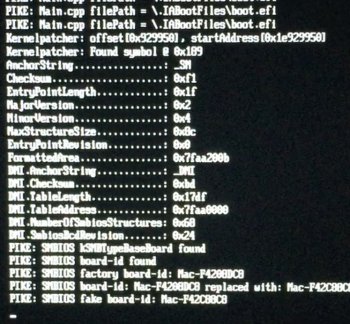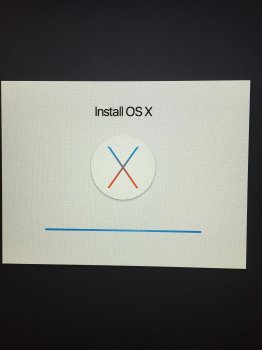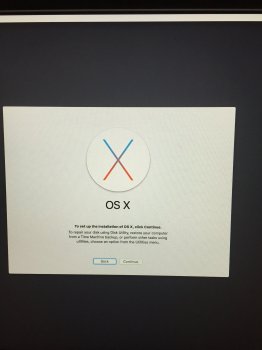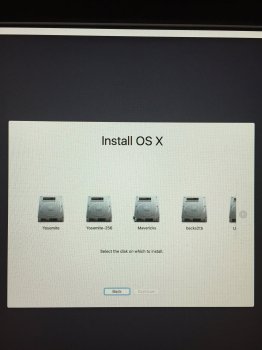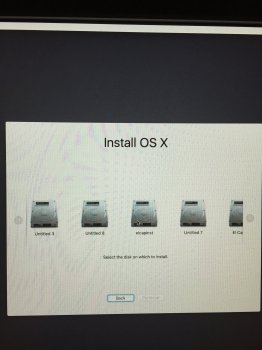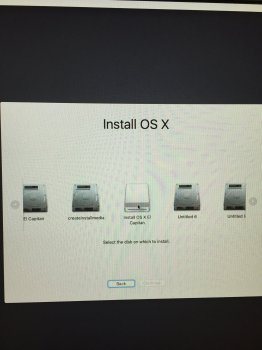Got a tip for us?
Let us know
Become a MacRumors Supporter for $50/year with no ads, ability to filter front page stories, and private forums.
macOS boot.efi developer's thread
- Thread starter mikeboss
- Start date
- Sort by reaction score
You are using an out of date browser. It may not display this or other websites correctly.
You should upgrade or use an alternative browser.
You should upgrade or use an alternative browser.
You are mistaken. The build of #466 was NOT supposed to be black. I know this for a fact, because I made it. Whenever I caused a commit to generate a "black" boot.efi I explicitly said so. I haven't done that for some time now.
Great. At least I know #466 is behaving properly then. I did notice that you mention when it's black. Now that my board id is showing as a 3,1 - I can't wait to verify the next update from the App Store... You're doing a fantastic job guys.
Fix kernel patcher.
To everyone interested in this project:
[P]eople must be aware that [this and other] interim future versions are NOT intended as a replacement for the official repository versions. Until further notice, those of you who want to use Pike's boot.efi ought to go to http://piker-alpha.github.io/macosxbootloader/ and download either the "black" version or the "grey" one, according to your particular preference (the change is purely cosmetic; otherwise, they are exactly the same; the choice is irrelevant as far as the operating system is concerned). Pike alone will decide when such repository versions will be updated with a newer version.
Please, notice that the [enclosed and other] upcoming experimental versions might contain bugs that could cripple your ability to boot your old Mac. So, unless you are absolutely certain of what you are doing and know how to reverse such undesirable situations, KEEP AWAY FROM THEM. In general terms, [these] versions ARE NOT FOR YOU!
Attachments
It's not easy to get a picture of the Kernel Panic because it comes very suddenly and then the MBP restarts.
But here it is:
View attachment 594029
Transferred OSX 10.11 - only both Boot.efi replaced.
The fake Board-ID seems to work (MBP3,1 instead of MBP2,2).
Hi atvusr,
That KP was caused by one of the metadata processes (aka Spotlight). It seems odd that you are having trouble. Have you read or heard from others with similar KP issues? What I'm thinking is that the issue might be related to your machine.
Since it's spotlight, you might want to check your hard drive, see if SMART is reporting the drive is okay. Run Disk Utility > First Aid on your drive (preferably when booted from a different drive). You might also try erasing the mds stores. From the Terminal you could try mdutil -E [mountpoint] or mdutil -Ea for all volumes.
Are you using spinning media or an SSD?
That KP was caused by one of the metadata processes (aka Spotlight). It seems odd that you are having trouble. Have you read or heard from others with similar KP issues? What I'm thinking is that the issue might be related to your machine.
The Kernel Panic occurred in all 3 scenario: legacy Installer / createinstallmedia Installer / transferred OSX. Mostly it was a Kernel trap, type 13=general protection. Others had Kernel Panics too, see e.g. Post #40, #46, #401. Apart from OSX 10.11 the MBP as well as the Drive work very stable. It's a SSD connected via FireWire 800.
Last edited:
Indeed. I had one myself, but the problem was due to a legacy, incompatible kext. It had nothing to do with Pike's boot.efi. It has been quite some time, I think, ever since anyone else reported a kernel panic occurrence. The very circumstance that your kernel panic should appear minutes after successful boot is suspicious. In my case, for instance (this happened weeks ago), the kernel panic halted the boot process.The Kernel Panic occurred in all 3 scenario: legacy Installer / createinstallmedia Installer / transferred OSX. Mostly it was a page fault. Others had Kernel Panics too, see e.g. Post #40, #46, #401. Apart from OSX 10.11 the MBP as well as the Drive work very stable. It's a SSD connected via FireWire 800.
New commit available for compilation/testing.
Pike: any specific thing that needs to be tested on this build? Just a post of the debug output, or should we be trying to proceed with a full installation?
The very circumstance that your kernel panic should appear minutes after successful boot is suspicious.
Yep - it's strange, dunno what it is. It occurs only with El Capitan while Yosemite runs stable from the same drive on the partition next to it.
Commit 121ca8efc51b8f835dbd9f5f7dfe3d989273b566 causes Kernel Panics too in all 3 scenario: legacy Installer / createinstallmedia Installer (each Kernel trap, type 13=general protection, BSD-thread: ReportCrash / WindowServer) as well as transferred OSX (Double fault at 0xf... , BSD-thread: WindowServer).
Fix kernel patcher.
I've tried with this version of boot.efi. MAS installer is not launched when my Mac reboot. I boot on my clone instead. From there, I'm able to select my main partition in the Boot hard drive preferences panel, and I can boot back on Yosemite with this version of the boot.efi.
This is a specific test version. Like the next one will be.I've tried with this version of boot.efi. MAS installer is not launched when my Mac reboot. I boot on my clone instead. From there, I'm able to select my main partition in the Boot hard drive preferences panel, and I can boot back on Yosemite with this version of the boot.efi.
New commit available for compilation/testing.
Note: If this update won't show: "__ZN12KLDBootstrap21readStartupExtensionsEv" in a line, then we need to debug MachO.cpp, but I have to finish something else here.
Reducing debug output.
To everyone interested in this project:
[P]eople must be aware that [this and other] interim future versions are NOT intended as a replacement for the official repository versions. Until further notice, those of you who want to use Pike's boot.efi ought to go to http://piker-alpha.github.io/macosxbootloader/ and download either the "black" version or the "grey" one, according to your particular preference (the change is purely cosmetic; otherwise, they are exactly the same; the choice is irrelevant as far as the operating system is concerned). Pike alone will decide when such repository versions will be updated with a newer version.
Please, notice that the [enclosed and other] upcoming experimental versions might contain bugs that could cripple your ability to boot your old Mac. So, unless you are absolutely certain of what you are doing and know how to reverse such undesirable situations, KEEP AWAY FROM THEM. In general terms, [these] versions ARE NOT FOR YOU!
Attachments
This is a specific test version. Like the next one will be.
New commit available for compilation/testing.
Note: If this update won't show: "__ZN12KLDBootstrap21readStartupExtensionsEv" in a line, then we need to debug MachO.cpp, but I have to finish something else here.
Do you mean that it doesn't specially help that I try it to see how it works with the MAS installer ? I take no risk when I do that since I have my clone partition to boot on and a copy of a working boot.efi to put back in case of problem.
Commit 918ca48.This is a specific test version. Like the next one will be.
New commit available for compilation/testing.
Note: If this update won't show: "__ZN12KLDBootstrap21readStartupExtensionsEv" in a line, then we need to debug MachO.cpp, but I have to finish something else here.
That line doesn't show up in the debug output. Now the debug output is as follows:
Code:
Kernelpatcher: offset[0x929950], startAddress[0x1df29950]
Kernelpatcher: Found symbol @ 0x109Then it doesn't finish booting, but instead fails with HFS mount errors. They are hard to read due to text overlaid over text. I will try to read and type it out in another post.
I took some photos but no way to post them online at the moment. Let me know if you need to see the actual images.
Last edited:
Code:
hfs_swap_BTNode: invalid node kind (90)
hfs: node = 0 fileID=3 volume= device=root_device
hfs_mounthfsplus: BTOpenPath returned (5) getting extentoverflow BT
hfs_mounthfsplus: encountered error (5)
hfs_mountfs: encountered failure 5
hfs_mountroot: hfs_mountfs returned 5. rvp (<ptr>) name (unknown device)
hfs_mountroot failed: 5
cannot mount root. errno = 19
rooting via boot-uuid from /chosen: <<<<UUID here>>>>
Waiting on <dict ID="0"><key>IOProviderClass</key><string ID="1">IOResources</string><key><IOResourceMatch</key><string ID="2"><boot-uuid-media</string></dict>So in the end, it loops these errors, but with some garbled black text in the background making it hard to read and photograph. No guarantees that there aren't some typos in the above.
EDIT: If this is unexpected, it could be possible that my USB stick was somehow corrupted. It doesn't mount on my other machine anymore. Formatting and retrying.
EDIT 2: It seems the stick was corrupt after all. After formatting, I boot to the installer GUI without a problem. Sorry if I wasted anybody's time.
Last edited:
commit 918ca48a
boot into createinstallmedia:
Kernelpatcher: offset[ox929950], startAdress[0x4329950]
Kernelpatcher: found symbol @ 0x189
boot into legacy installer:
Kernelpatcher: offset[0x9299950, startAddress[0x1c929950]
Kernelpatcher: found symbol @ 0x189
Initial boot into createinstallmedia gave me the OS X Utilities chooser, while the initial boot into legacy gave me the Install OS X (with a long, blue progress-bar for about five seconds), then the "To set up the installation of OS X, click Continue" modal.
I've re-tried each three times, and I'm now getting the "To set up the installation of..." on each.
The only way I can describe these boots is "wonky".
btw, I can continue the Installation, if I choose to do so (see attached)....
boot into createinstallmedia:
Kernelpatcher: offset[ox929950], startAdress[0x4329950]
Kernelpatcher: found symbol @ 0x189
boot into legacy installer:
Kernelpatcher: offset[0x9299950, startAddress[0x1c929950]
Kernelpatcher: found symbol @ 0x189
Initial boot into createinstallmedia gave me the OS X Utilities chooser, while the initial boot into legacy gave me the Install OS X (with a long, blue progress-bar for about five seconds), then the "To set up the installation of OS X, click Continue" modal.
I've re-tried each three times, and I'm now getting the "To set up the installation of..." on each.
The only way I can describe these boots is "wonky".
btw, I can continue the Installation, if I choose to do so (see attached)....
Attachments
Last edited:
Commit 918ca48
Doesn't show it for me on both install media, the output is the same as randyoo's and splifingate's.Note: If this update won't show: "__ZN12KLDBootstrap21readStartupExtensionsEv" in a line, then we need to debug MachO.cpp, but I have to finish something else here.
Do you mean that it doesn't specially help that I try it to see how it works ...
----8<------
We are Pike's Eyes (and ears, it would seem (large as we must be <smile>)) . . . psot teh feedback, as best you can, and as often you can . . . Pike is robust-enough to weather those things that don't necessarily pertain to his Task At Hand
It's important to get some reciprocal perspective on these matters.
Thanks for participating.
Regards, splifingate
Hi,commit 918ca48a
boot into createinstallmedia:
Kernelpatcher: offset[ox929950], startAdress[0x4329950]
Kernelpatcher: found symbol @ 0x189
boot into legacy installer:
Kernelpatcher: offset[0x9299950, startAddress[0x1c929950]
Kernelpatcher: found symbol @ 0x189
Initial boot into createinstallmedia gave me the OS X Utilities chooser, while the initial boot into legacy gave me the Install OS X (with a long, blue progress-bar for about five seconds), then the "To set up the installation of OS X, click Continue" modal.
I've re-tried each three times, and I'm now getting the "To set up the installation of..." on each.
The only way I can describe these boots is "wonky".
btw, I can continue the Installation, if I choose to do so (see attached)....
Thanks for testing. We're no longer interested in these two:
Kernelpatcher: offset[0x9299950, startAddress[0x1c929950]
Kernelpatcher: found symbol @ 0x189
Thing is. There should be a second set of lines, with different values, but they are still missing.
Another thing. Have you checked the NVRAM variables in the installer (open a terminal window if you can) that I asked for a little while ago?
Hi,
Thanks for testing. We're no longer interested in these two:
Kernelpatcher: offset[0x9299950, startAddress[0x1c929950]
Kernelpatcher: found symbol @ 0x189
Thing is. There should be a second set of lines, with different values, but they are still missing.
Another thing. Have you checked the NVRAM variables in the installer (open a terminal window if you can) that I asked for a little while ago?
I'd be happy to do this, but I think there's no way to open a terminal window in the second stage of the installer. No way to multitask, period. Can open a terminal window prior to installation, but after starting install, no more GUI interaction is possible except to cancel install.
Could be possible during second stage to boot into single user mode. I can try that, if you'd like.
Here are the contents of my nvram having booted from the installer, but not yet starting the installation:
I'll now try to get into single user mode during the second stage of the install, to try to see the differences.
Code:
bash-3.2# nvram -p
IdlePML4 %d0%da%0e%17%80%ff%ff%ff
boot-gamma d"%00%00%91%89%00%00%00%00%00%00%82%00%00%00%00%00%00%00%09%00%c1%07%80%02D%12%c6%07G%1f%d8%0fK,%1c%19%92HD0%dai%8cO%e2%8b%0bs,%b0%1c%9c%f5%d5%e4%c9%09%00%81%07"%02%84%12%0c%07%07%1e]%0d%0b,0%16%d2I%f4+%9aj|Gc%8c%e8f,%b2%13%8d%f5%d6%db%b4%08%00%02%08%ef%01D%12%c4%05%8a+5%12%92H%cd#%dai%01;b%8b%eeTl%b1%e2t%b5%d6s%96
boot-args kext-dev-mode=1
BootCampHD %02%01%0c%00%d0A%03%0a%00%00%00%00%01%01%06%00%02%1f%03%12%0a%00%01%00%00%00%00%00%7f%ff%04%00
prev-lang:kbd en:0
SystemAudioVolumeDB %00
platform-uuid %00%00%00%00%00%00%10%00%80%00%00%17%f2%0b%cfD
efi-boot-device <array><dict><key>IOMatch</key><dict><key>IOProviderClass</key><string>IOMedia</string><key>IOPropertyMatch</key><dict><key>UUID</key><string>62B514A3-XXXX-XXXX-XXXX-5C03E6XXXXXX</string></dict></dict><key>BLLastBSDName</key><string>disk0s2</string></dict></array>%00
efi-boot-device-data %02%01%0c%00%d0A%03%0a%00%00%00%00%01%01%06%00%02%1f%03%12%0a%00%00%00%00%00%00%00%04%01*%00%02%00%00%00(@%06%00%00%00%00%00%c0/%e3%06%00%00%00%00%a3%14%b5bq%9e%eb@%b7%c0\%03%e6%afW%b4%02%02%7f%ff%04%00
csr-active-config %80%00%00%00
SystemAudioVolume @
fmm-computer-name admin%e2%80%99s Mac Pro
LocationServicesEnabled %01
-bash-3.2#I'll now try to get into single user mode during the second stage of the install, to try to see the differences.
Last edited:
I'd be happy to do this, but I think there's no way to open a terminal window in the second stage of the installer. No way to multitask, period. Can open a terminal window prior to installation, but after starting install, no more GUI interaction is possible except to cancel install.
Could be possible during second stage to boot into single user mode. I can try that, if you'd like.
You can start the terminal after the installer completes and starts counting down to restart. The restart is cancelled whilst you have other utilities open, and restarts the countdown when they are all closed (at least in legacy installer, I haven't tried with createinstallmedia)
I'll now try to get into single user mode during the second stage of the install, to try to see the differences.
Okay, I'm in, and the only difference I can spot in NVRAM variables is the following new variable:
Code:
install-product-url x-osproduct://<<<disk UUID here>>>/OS%2520X%2520Install%2520DataThis is after the first reboot from performing an install using a "createinstallmedia" installer, having booted into single user mode.
I'll try rthpjm's suggestion now, after rebooting and completing the installation.
EDIT: After completing installation, prior to restart timer, checked NVRAM variables, and they are identical to beginning of installation. (install-product-url is gone, exactly same as post #523 now)
Last edited:
Register on MacRumors! This sidebar will go away, and you'll see fewer ads.




